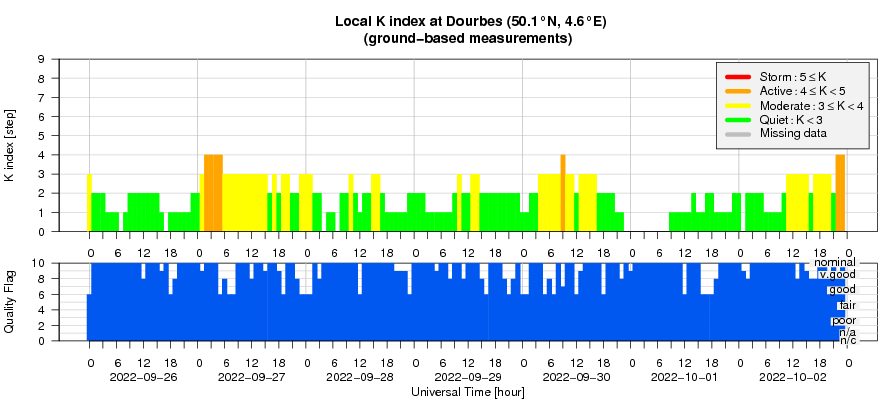- Table of Content
- 1.Whodunit
- 2.The Space Pole...
- 3.Review of sola...
- 4.Review of geom...
- 5.PROBA2 Observa...
- 6.The Internatio...
- 7.Noticeable Sol...
- 8.Geomagnetic Ob...
- 9.The SIDC Space...
- 10.Action!
2. The Space Pole Open doors - the movie
3. Review of solar activity
4. Review of geomagnetic activity
5. PROBA2 Observations (26 Sep 2022 - 2 Oct 2022)
6. The International Sunspot Number by SILSO
7. Noticeable Solar Events (26 Sep 2022 - 2 Oct 2022)
8. Geomagnetic Observations at Dourbes (26 Sep 2022 - 2 Oct 2022)
9. The SIDC Space Weather Briefing
10. Action!
Whodunit
The Sun did not take a weekend break, as it produced an M5.8 flare on 1 October peaking at 20:10UTC, an M8.7 on 2 October at 02:21UTC, and a X1 flare at 20:25UTC. And this was on top of a number of low-level M-class flares starting already on 30 September. The strongest flares are highlighted in the soft x-ray plot by GOES (https://www.swpc.noaa.gov/products/goes-x-ray-flux ) underneath, covering 1-3 October.
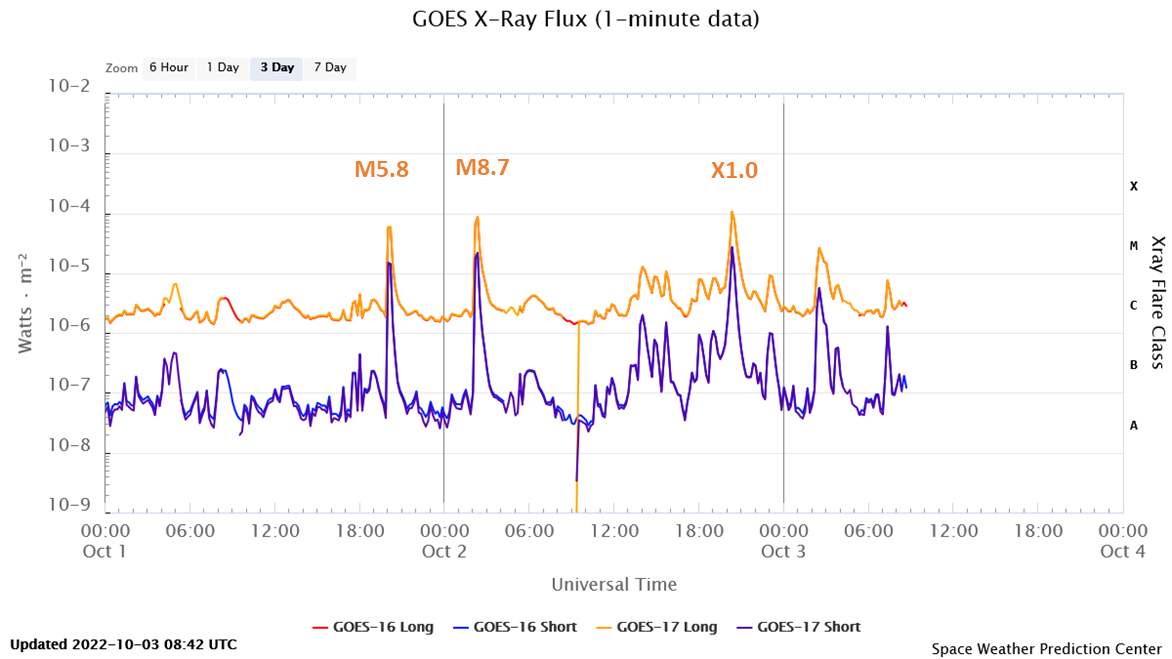
One would expect that these flares were produced by the large and complex sunspot region NOAA 3112. This region had started to rotate over the northeast limb on 30 September, and had a sunspot area equivalent to about 4 times the surface area of the Earth by the end of 2 October. The region also contained several delta spots, indicated by the red circles in the imagery underneath. A sunspot group is said to have a delta structure when it contains at least one mature spot in which umbrae of opposite magnetic polarities are separated by less than 2 degrees and situated within the common penumbra. This is shown in the comparison images underneath, with a white light image on the left and a magnetogram on the right as taken by the SDO/HMI instrument (http://sdo.gsfc.nasa.gov/data/aiahmi/ ). White indicates magnetic field lines leaving the Sun ("positive polarity"), black indicates magnetic field lines returning to the Sun ("negative polarity"). Delta spots are known for their flare productive character.

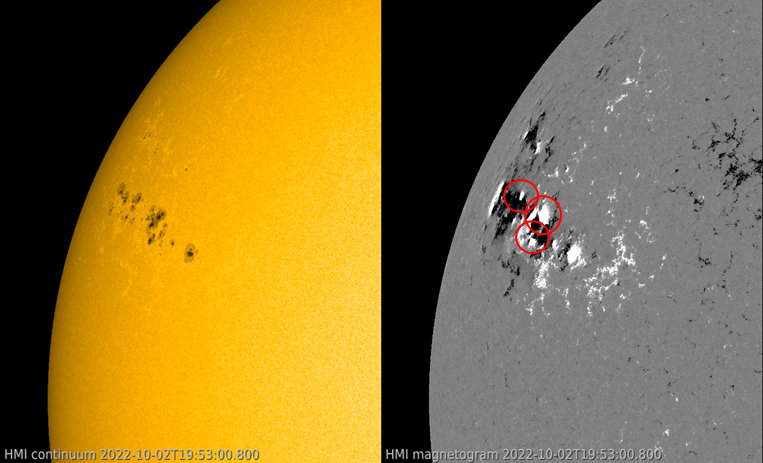
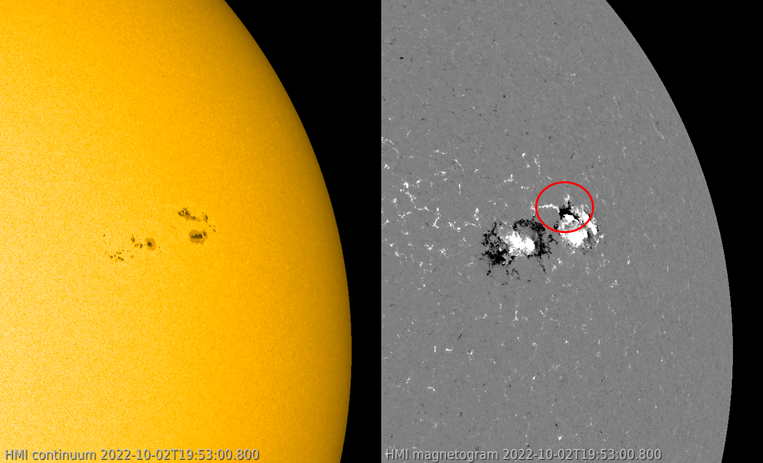
Interestingly, the flaring production of NOAA 3112 has remained limited (so far) to low-level M-class flaring (M1, M2). The strong flares mentioned earlier all came from NOAA 3110, which was a stable symmetrical sunspot until 1 October, when it started to develop some small spots to its west and north. As indicated by the red circle in the image above, these contained a delta structure setting off the observed strong flaring on 1 and 2 October. The imagery below shows the X1 flare from NOAA 3110 in white light and in extreme ultraviolet. The blooming and diffraction patterns are image artefacts, not related to the flare - See this STCE newsitem at https://www.stce.be/news/499/welcome.html for more info.
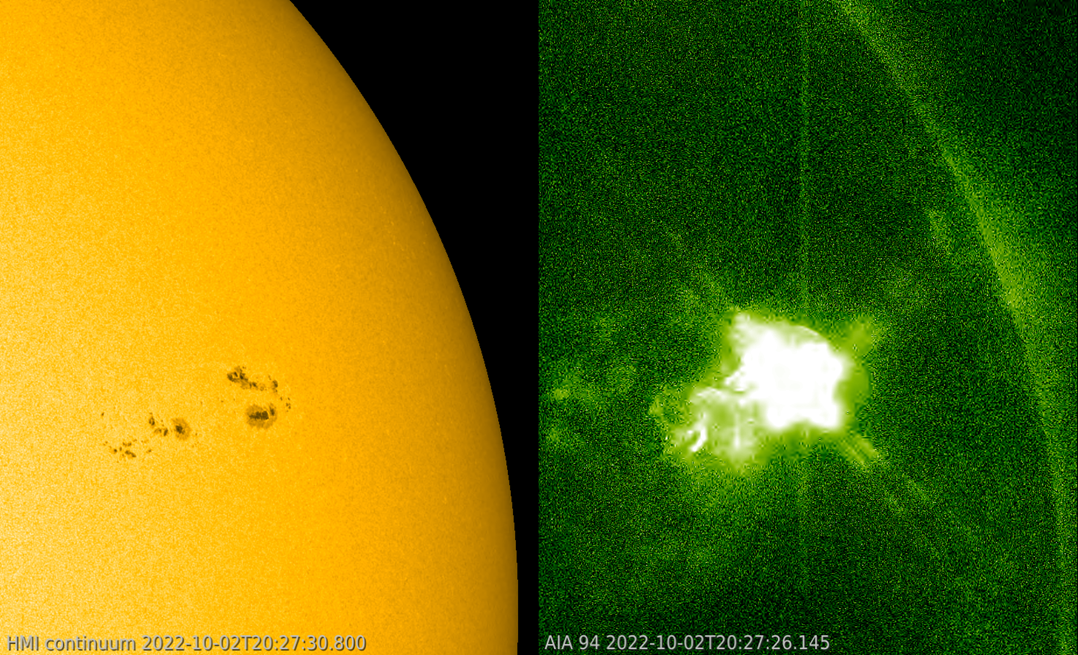
The X1 flare was the strongest event so far, being accompanied by some strong radio emission affecting GNSS frequencies as well as the observed 10.7cm radio flux, which is daily measured by Penticton, Canada between 19:30 and 20:30UTC. It also slightly enhanced the greater than 10 MeV proton flux, which remained well below the alert threshold. Most of the coronal mass ejections (CMEs) related to the solar eruptions from the last few days apparently were not squarely directed at Earth. Nonetheless, they can still deliver a glancing blow during the coming days (most likely on 4 October), thus increasing the chance on a reasonably strong geomagnetic storm.
Underneath a coronagraphic image with an EUV image of the Sun (SDO/AIA) overlaid, showing the CME associated with the X1 flare being mostly directed to the northwest (upper right of the image). The bright spot is the planet Venus, currently located at the opposite side of the Sun as seen from Earth. Clips are in the online version of this article at https://www.stce.be/news/607/welcome.html Both NOAA 3110 and 3112 may continue to produce strong flares in the coming days, but associated CMEs from NOAA 3110 will become less likely to have an earth-directed component, as the region is rotating towards the Sun's west limb. For NOAA 3112, it's just the reverse, as the region is moving towards the disk centre.
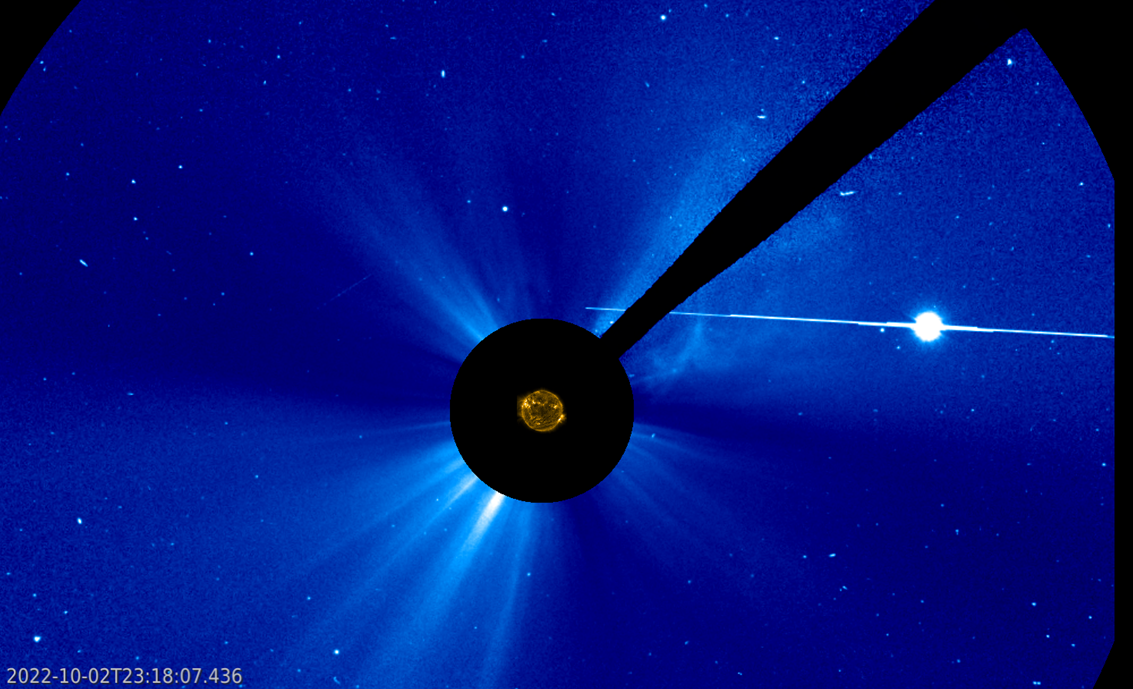
The Space Pole Open doors - the movie
The open doors at the Space Pole were successful: https://www.stce.be/images/2022_OBS_Portes_Ouvertes_Video_Olivier_Boulvin.mp4
Enjoy!

Review of solar activity
Solar flares
Solar flaring activity was at low levels at the start of the week. Activity increased to moderate levels on September 29 and 30 and reached high levels on October 01 and 02. In the middle of the week, most of the flaring activity was associated with NOAA AR 3112, which began to rotate onto the disk over the east limb and produced multiple M-class flares. From Oct 01, NOAA AR 3110, which had previously been stable, began to display flux emergence and produced multiple high-level M-class flares and the largest flare of the week: an X1 flare on October 02 that peaked at 20:25 UTC. This event was also associated with a Type II radio burst. During the week, there were six other active regions on the disk but these were mostly simple regions that produced only C-class flares.
Coronal Mass Ejections
A CME associated with a filament eruption from the north-east quadrant, seen in SDO/304 at 04:48 UT on September 28, was predicted to have a possibility to arrive at Earth on October 01. A C3.5 flare from NOAA AR 3113 on October 01, was also associated with a filament eruption that began to lift off around 11:59 UT seen in SDO/AIA 304. An associated partial halo Coronal Mass Ejection (CME) can be seen from 12:40 UT in LASCO/C2 and was deemed to have a possible Earth directed component.
Coronal Holes
At the start of the week, on September 27-29, a large trans-equatorial positive polarity coronal hole transited the central meridian.
Solar energetic particles
The greater than 10 MeV proton flux was slightly enhanced, but remained well below the radiation storm threshold. The greater than 2 MeV electron flux was above the 1000 pfu threshold at the start of the week, reducing to nominal levels from September 27. The 24h electron fluence was at moderate levels on September 26 and 27, and reduced to nominal levels for the remainder of the week.
Review of geomagnetic activity
The solar wind parameters were at nominal values on September 26. On September 27, the solar wind parameters reflected the arrival of a CIR ahead of the expected high-speed stream from a negative polarity coronal hole and possibly combined with a transient feature. The solar wind speed increased from 300 km/s to values over 600 km/s on September 27. The interplanetary magnetic field increased and reached over 30 nT at 04:30 UT, with a minimum Bz of -17nT. On September 29, the orientation of the magnetic field changed from the negative to the positive sector (field away from the Sun). The solar wind speed remained elevated for the rest of the week with values between 500 and 600 km/s, due to the further influence of the high-speed stream from the positive polarity hole that crossed the central meridian on September 27. A small shock-like feature was observed at 15:04 on October 01, where the magnetic field increased to 10nT.
Geomagnetic conditions were quiet on 26 September. On September 27, there was then an isolated period of moderate storm levels (NOAA Kp = 6 between 00:00 UT and 03:00 UT) in reaction to the strong negative magnetic field, before reducing again to active and unsettled conditions from 03 UT (NOAA Kp 2-4, local K-Dourbes 3-4). The geomagnetic conditions for the rest of the week were mostly at quiet to unsettled levels with a few periods of active conditions on September 30.
PROBA2 Observations (26 Sep 2022 - 2 Oct 2022)
Solar Activity
Solar flare activity fluctuated from low to high during the week.
In order to view the activity of this week in more detail, we suggest to go to the following website from which all the daily (normal and difference) movies can be accessed: https://proba2.oma.be/ssa
This page also lists the recorded flaring events.
A weekly overview movie can be found here (SWAP week 653). https://proba2.sidc.be/swap/data/mpg/movies/weekly_movies/weekly_movie_2022_09_26.mp4
Details about some of this week's events can be found further below.
If any of the linked movies are unavailable they can be found in the P2SC movie repository here https://proba2.sidc.be/swap/data/mpg/movies/
Sunday Oct 02
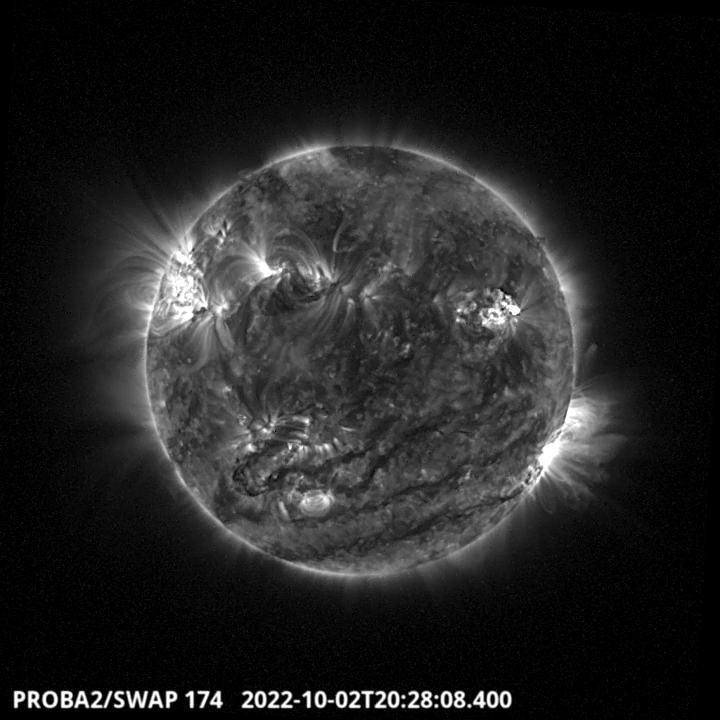
The largest flare of the week is a X1.0, it has been produced by the NOAA active region 3110 in
the North-West Hemisphere around 20:28 UT - SWAP image. Find a movie of the events here (SWAP movie) https://proba2.sidc.be/swap/data/mpg/movies/20221002_swap_movie.mp4
The International Sunspot Number by SILSO
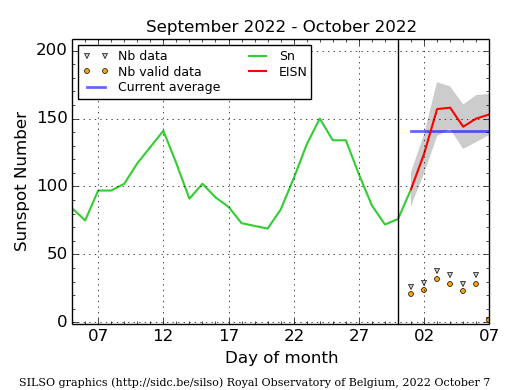
The daily Estimated International Sunspot Number (EISN, red curve with shaded error) derived by a simplified method from real-time data from the worldwide SILSO network. It extends the official Sunspot Number from the full processing of the preceding month (green line), a few days more than one solar rotation. The horizontal blue line shows the current monthly average. The yellow dots give the number of stations that provided valid data. Valid data are used to calculate the EISN. The triangle gives the number of stations providing data.
Noticeable Solar Events (26 Sep 2022 - 2 Oct 2022)
| DAY | BEGIN | MAX | END | LOC | XRAY | OP | 10CM | TYPE | Cat | NOAA |
| 30 | 0346 | 0401 | 0651 | M1.0 | VI/2 | 3112 | ||||
| 30 | 1611 | 1622 | 1633 | M2.9 | 3112 | |||||
| 30 | 1730 | 1734 | 1745 | M1.3 | 3112 | |||||
| 01 | 1958 | 2010 | 2016 | N18W36 | M5.8 | 1B | III/3III/2 | 48 | 3110 | |
| 02 | 0208 | 0221 | 0226 | N16W34 | M8.7 | 1N | 190 | VI/3IV/1 | 48 | 3110 |
| 02 | 1352 | 1405 | 1423 | N25E73 | M1.2 | SF | III/1VI/1 | 3112 | ||
| 02 | 1534 | 1545 | 1553 | N22E69 | M1.0 | SF | 3112 | |||
| 02 | 1953 | 2025 | 2034 | X1.0 | 560 | III/2II/2 | 48 | 3110 |
| LOC: approximate heliographic location | TYPE: radio burst type |
| XRAY: X-ray flare class | Cat: Catania sunspot group number |
| OP: optical flare class | NOAA: NOAA active region number |
| 10CM: peak 10 cm radio flux |
The SIDC Space Weather Briefing
The Space Weather Briefing presented by the forecaster on duty from 25 Sep to Oct 2, 2022. It reflects in images and graphs what is written in the Solar and Geomagnetic Activity report: https://www.stce.be/briefings/20221003_SWbriefing.pdf

If you need to access the movies, contact us: stce_coordination at stce.be
Action!
Check out our activity calendar: activities and encounters with the Sun-Space-Earth system and Space Weather as the main theme. We provide occasions to get submerged in our world through educational, informative and instructive activities.
If you want your event in our calendar, contact us: stce_coordination at stce.be
* October 11, Webinar: Putting the FAIR principles into practice: the journey of a GNSS data repository, GNSS@Royal Observatory of Belgium
* October 20, Job vacancy EUI onboard Solar Orbiter - last day for submission
* October 21, seminar: Detecting Europa’s Water Plumes, onsite and online, Royal Observatory of Belgium
* October 24-28, 18th European Space Weather Week, Zagreb, Croatia
* November 21-23, Space Weather Introductory Course - onsite, by the STCE, Brussels, Belgium - fully booked
* December 5, 6, 8, 9, Space Weather Introductory Course - online, by the STCE, zoom - fully booked
Check: https://www.stce.be/calendar

